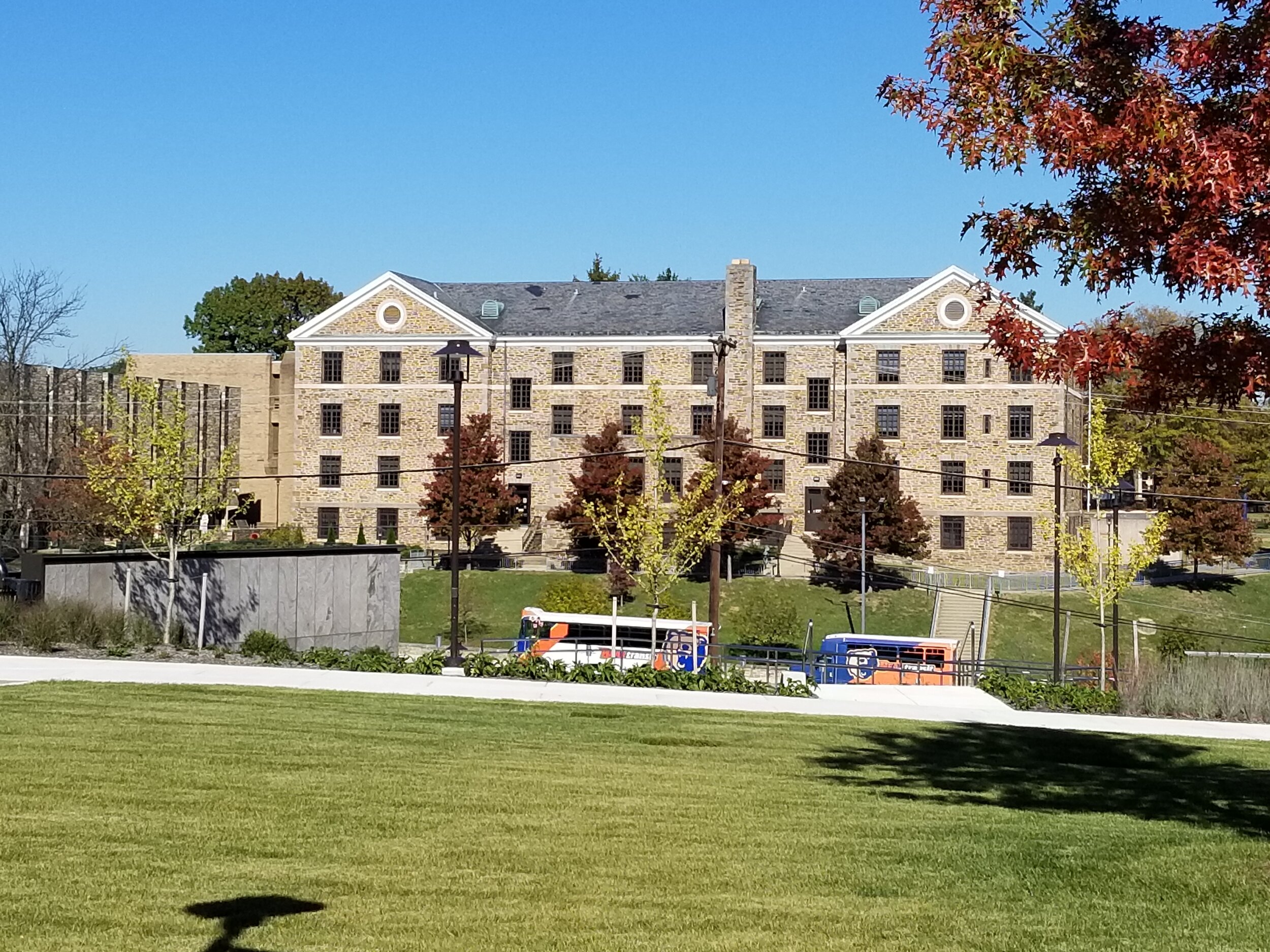Water issues in both Truth Hall and Memorial Chapel at the Morgan State University campus were creating problems for several university services, including a childcare facility.

Truth Hall

When two historic stone structures on the campus of Morgan State University in Maryland were taking on water, the administration called on the help of Murphy & Dittenhafer Architects to find out why and how it could be fixed.
Both Truth Hall and Memorial Chapel are defining buildings for the University. They were designed in the 1940s by Architect Albert Irvin Cassell, whose work shaped many of the region’s predominantly Black institutions of higher education, including Howard University and Virginia Union University.
Truth Hall, built in 1946, was named in honor of Sojourner Truth, one of the most notable anti-slavery speakers during the years leading up to the Civil War. She went to Washington at the beginning of the Civil War to help care for wounded Union Soldiers and met with President Abraham Lincoln, upon whom she urged the arming of free Black Americans of the North for the defense of the Union.
Like us on Facebook!
The building constructed in her memory was originally a women’s residence but converted to an administrative building in 1979. It currently houses the President, Senior Administration, and support staff.
Originally named the Morgan Christian Center, Memorial Chapel reflects the diverse religious landscape on campus. Built in 1941, it is included, along with Truth Hall, on the National Registry of Historic Places.
A troubling issue
When both facilities started mysteriously experiencing water issues, primarily in the Lower Level (basement), it was a cause for concern, not only for the historical integrity of the structures but for the programs and administrators that were impacted by the water issues.
Office workers could no longer work in the basement of Truth Hall because of standing water in numerous locations. The childcare facility in the basement of Memorial Chapel also had to be relocated, raising concerns for exposure to mold.
“It’s not uncommon to find infiltration issues with historical buildings,” says Lauren Myatt, Principal Architect at Murphy & Dittenhafer Architects. “Construction practices, technology, and other common things weren’t around when these buildings were created.”
Finding the source of the problem wouldn’t be so simple. Rather, it’d take a team of experts and the resources that M&D could tap into via industry connections.

Truth Hall
The investigation
Peter Schwab, Architect at Murphy & Dittenhafer Architects, knows the importance of these types of projects. Finding the reason behind the water problem, and then helping prevent it in the future, can mean these structures will last for generations to come.
The investigation to determine where the water is entering the building is still ongoing. It includes the work of a civil engineer, a geotechnical engineer, a utility locator, and some assistance from a demolition contractor, as well as a prominent roofing company which is doing drone work to get a look at how nearby trees might be carrying water onto the top of the buildings.
Some pipes were dug up and replaced. Others that had blockages were cleaned out, and camera scopes were used to inspect even more pipes.
Five test pits around Truth Hall and four around Memorial Chapel will also be dug to determine if water is present around the stone foundation of the building, to see if water could be hitting the concrete footing and traveling under the stone.
The 2-foot-thick stone walls of the chapel also has some cavities – some the size of grapefruit – that are of concern. While storm drain lines are clear around the chapel, it is unclear if they are causing problems at Truth Hall.
Experts working together
While the work involves a lot of research and fact finding, Schwab recognizes how important it can be to figure out a long-term solution for Morgan State University.
“I have 40 years of experience, and I still find these projects to be some of the most challenging,” Schwab says. “It’s not an easy solution. It’s not something that we can quickly point to the problem. It takes time. It takes coordination. It’s a large, research-based project.”
For Schwab, who worked on some of the campus buildings 25 years ago, it’s nice to have a chance to be helping Morgan State University preserve its history.
“We have the connections that we can bring in many experts to help solve this for them,” he says. “Sometimes, finding a solution involves a lot of people working together. This is one of those projects.”
At Murphy & Dittenhafer Architects, we feel lucky to have such awesome employees who create meaningful and impressive work. Meet the four team members we welcomed in 2024.
The ribbon-cutting ceremony at the new Department of Legislative Services (DLS) office building in Annapolis honored a truly iconic point in time for the state of Maryland.
As Murphy & Dittenhafer architects approaches 25 years in our building, we can’t help but look at how far the space has come.
Murphy & Dittenhafer Architects took on the Architecture, Interior Design, & Overall Project Management for the new Bedford Elementary School, and the outcome is impactful.
The memorial’s groundbreaking took place in June, and the dedication is set to take place on November 11, 2024, or Veterans Day.
President of Murphy & Dittenhafer Architects, Frank Dittenhafer II, spoke about the company’s contribution to York-area revitalization at the Pennsylvania Downtown Center’s Premier Revitalization Conference in June 2024. Here are the highlights.
The Pullo Center welcomed a range of student musicians in its 1,016-seat theater with full production capabilities.
“Interior designs being integral from the beginning of a project capitalize on things that make it special in the long run.”
Digital animations help Murphy & Dittenhafer Architects and clients see designs in a new light.
Frank Dittenhafer and his firm work alongside the nonprofit to fulfill the local landscape from various perspectives.
From Farquhar Park to south of the Codorus Creek, Murphy & Dittenhafer Architects help revamp York’s Penn Street.
Designs for LaVale Library, Intergenerational Center, and Beth Tfiloh Sanctuary show the value of third places.
The Annapolis Department of Legislative Services Building is under construction, reflecting the state capital’s Georgian aesthetic with modern amenities.
For the past two years, the co-founder and president of Murphy & Dittenhafer Architects has led the university’s College of Arts and Architecture Alumni Society.
The firm recently worked with St. Vincent de Paul of Baltimore to renovate an old elementary school for a Head Start pre-k program.
The market house, an 1888 Romanesque Revival brick structure designed by local Architect John A. Dempwolf, long has stood out as one of York’s premier examples of Architecture. Architect Frank Dittenhafer is passing the legacy of serving on its board to Architectural Designer Harper Brockway.
At Murphy & Dittenhafer Architects, there is a deep-rooted belief in the power of combining history and adaptive reuse with creativity.
University of Maryland Global Campus explores modernizing its administration building, which serves staffers and students enrolled in virtual classes.
The Wilkens and Essex precincts of Baltimore County are receiving solutions-based ideas for renovating or reconstructing their police stations.
The firm has earned the designation annually since 2016 in recognition of its commitment to supporting newer professionals in the field.
Murphy & Dittenhafer Architects recently completed the Design Development phase for a 20,000-square-foot building for Crispus Attucks York. Construction should begin in August.
The facility in Anne Arundel County, Maryland, is re-envisioning its focus with the help of Murphy & Dittenhafer Architects.
Murphy & Dittenhafer Architects received numerous awards from AIA Pennsylvania, AIA Central Pennsylvania, AIA Baltimore, and ABC Keystone.
Since 2019, the firm has designed a number of protected entryways for Anne Arundel County Public Schools.
A business lunch at an iconic building sparked an awakening whose effects continue to ripple down the city thoroughfare.


































Harford Community College’s expanded new construction Chesapeake Welcome Center is a lesson in Architectural identity